
Roy Fox Lichtenstein was an American pop artist. During the 1960s, along with Andy Warhol, Jasper Johns, and James Rosenquist, he became a leading figure in the new art movement. His work defined the premise of pop art through parody. Inspired by the comic strip, Lichtenstein produced precise compositions that documented while they parodied, often in a tongue-in-cheek manner. His work was influenced by popular advertising and the comic book style. His artwork was considered to be "disruptive". He described pop art as "not 'American' painting but actually industrial painting". His paintings were exhibited at the Leo Castelli Gallery in New York City.

Whaam! is a 1963 diptych painting by the American artist Roy Lichtenstein. It is one of the best-known works of pop art, and among Lichtenstein's most important paintings. Whaam! was first exhibited at the Leo Castelli Gallery in New York City in 1963, and purchased by the Tate Gallery, London, in 1966. It has been on permanent display at Tate Modern since 2006.

Girl with Ball is a 1961 painting by Roy Lichtenstein. It is an oil on canvas Pop art work that is now in the collection of the Museum of Modern Art, after being owned for several decades by Philip Johnson. It is one of Lichtenstein's earliest Pop art works and is known for its source, which is a newspaper ad that ran for several decades and which was among Lichtenstein's earliest works sourced from pop culture.

Torpedo...Los! is a 1963 pop art oil on canvas painting by Roy Lichtenstein. When it was last sold in 1989, The New York Times described the work as "a comic-strip image of sea warfare". It formerly held the record for the highest auction price for a Lichtenstein work. Its 1989 sale helped finance the construction of the current home of the Museum of Contemporary Art, Chicago in 1991.

Look Mickey is a 1961 oil on canvas painting by Roy Lichtenstein. Widely regarded as the bridge between his abstract expressionism and pop art works, it is notable for its ironic humor and aesthetic value as well as being the first example of the artist's employment of Ben-Day dots, speech balloons and comic imagery as a source for a painting. The painting was bequeathed to the Washington, D.C., National Gallery of Art upon Lichtenstein's death.
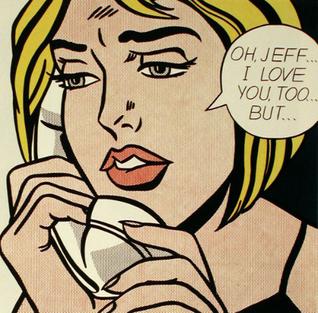
Oh, Jeff...I Love You, Too...But... is a 1964 oil and magna on canvas painting by Roy Lichtenstein. Like many of Lichtenstein's works its title comes from the speech balloon in the painting.

Big Painting No. 6 is a 1965 oil and Magna on canvas painting by Roy Lichtenstein. Measuring 235 cm × 330 cm, it is part of the Brushstrokes series of artworks that includes several paintings and sculptures whose subject is the actions made with a house-painter's brush. It set a record auction price for a painting by a living American artist when it sold for $75,000 in 1970. The painting is in the Kunstsammlung Nordrhein-Westfalen collection.
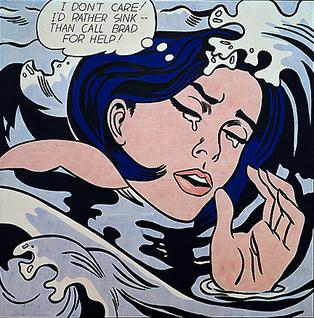
Drowning Girl is a 1963 American painting in oil and synthetic polymer paint on canvas by Roy Lichtenstein, based on original art by Tony Abruzzo. The painting is considered among Lichtenstein's most significant works, perhaps on a par with his acclaimed 1963 diptych Whaam!. One of the most representative paintings of the pop art movement, Drowning Girl was acquired by the Museum of Modern Art in 1971.

I Know...Brad is a 1964 pop art painting by Roy Lichtenstein that uses his classic Ben-Day dots and a speech balloon. The work is located at the Ludwig Forum für Internationale Kunst in Aachen. It is an example of how Lichtenstein used his artistry to make significant changes to the original comics sources.
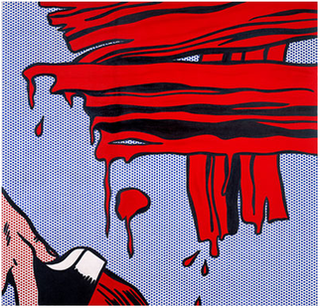
Brushstrokes series is the name for a series of paintings produced in 1965-1966 by Roy Lichtenstein. It also refers to derivative sculptural representations of these paintings that were first made in the 1980s. In the series, the theme is art as a subject, but rather than reproduce masterpieces as he had starting in 1962, Lichtenstein depicted the gestural expressions of the painting brushstroke itself. The works in this series are linked to those produced by artists who use the gestural painting style of abstract expressionism made famous by Jackson Pollock, but differ from them due to their mechanically produced appearance. The series is considered a satire or parody of gestural painting by both Lichtenstein and his critics. After 1966, Lichtenstein incorporated this series into later motifs and themes of his work.

Engagement Ring is a 1961 pop art painting by Roy Lichtenstein. The work is based on the Winnie Winkle series, but Lichtenstein changed both the graphical description and the narrative accompaniment that he presents in a speech balloon. As with most of his early romance comics works, this consisted of "a boy and a girl connected by romantic dialogue and action".
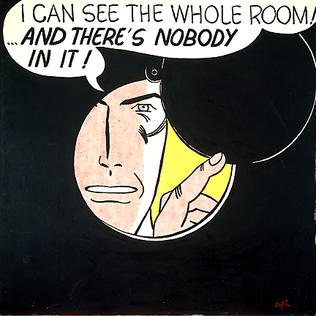
I Can See the Whole Room...and There's Nobody in It! is a 1961 painting by Roy Lichtenstein. It is a painting of a man looking through a peephole. It formerly held the record for highest auction price for a Lichtenstein painting.

Hopeless is a 1963 painting with oil paint and acrylic paint on canvas by Roy Lichtenstein. The painting is in the collection of the Kunstmuseum Basel.
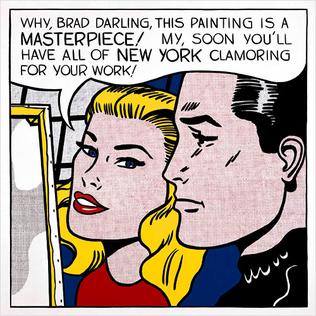
Masterpiece is a 1962 pop art painting by Roy Lichtenstein that uses his classic Ben-Day dots and narrative content contained within a speech balloon. In 2017, the painting sold for $165 million.
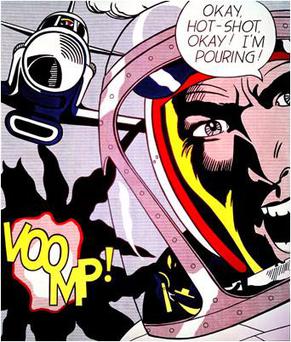
Okay Hot-Shot, Okay! is a 1963 pop art painting by Roy Lichtenstein that uses his Ben-Day dots style and a text balloon. It is one of several examples of military art that Lichtenstein created between 1962 and 1964, including several with aeronautical themes like this one. It was inspired by panels from four different comic books that provide the sources for the plane, the pilot, the text balloon and the graphic onomatopoeia, "VOOMP!".

Bratatat! is a 1963 pop art painting by Roy Lichtenstein in his comic book style of using Ben-Day dots and a text balloon.

Brattata is a 1962 pop art painting by Roy Lichtenstein in his comic book style of using Ben-Day dots and a text balloon. The work is held in the collection at the Tehran Museum of Contemporary Art. It is one of several Lichtenstein works from All-American Men of War issue #89, but is a reworking of its source panel.

Jet Pilot is a 1962 pop art work done in graphite pencil by Roy Lichtenstein. Like many of Lichtenstein's works from this time period, it was inspired by a comic book image, but he made notable modifications of the source in his work.

Varoom! is a 1963 pop art painting by Roy Lichtenstein that depicts an explosion and the onomatopoeic sound that gives it its name.

Crak! is a 1963 pop art lithograph by Roy Lichtenstein in his comic book style of using Ben-Day dots and a text balloon. It was used in marketing materials for one of Lichtenstein's early shows. It is one of several of his works related to military art and monocular vision.




















